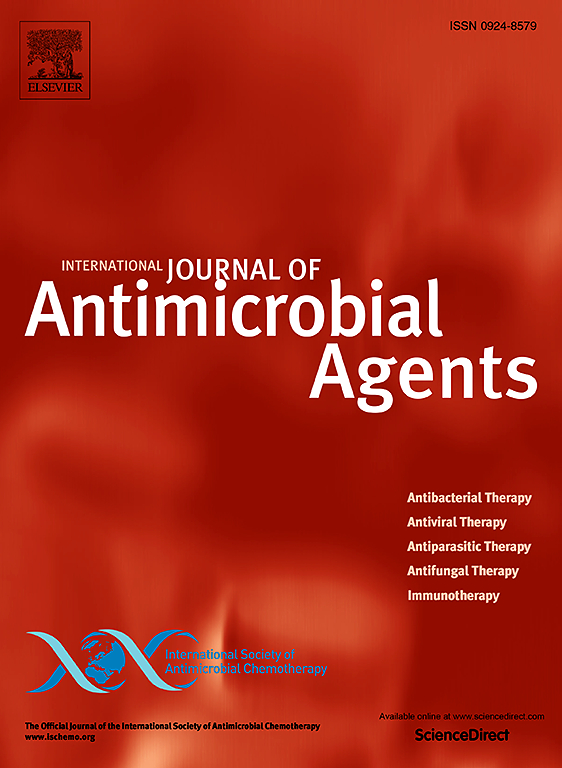用米诺环素代替利福平增加了动态中空纤维系统中鸟分枝杆菌复杂肺部疾病治疗方案的活性。
IF 4.9
2区 医学
Q1 INFECTIOUS DISEASES
International Journal of Antimicrobial Agents
Pub Date : 2025-02-01
DOI:10.1016/j.ijantimicag.2024.107423
引用次数: 0
摘要
鸟分枝杆菌复合细菌引起易感患者慢性肺部疾病(MAC-PD)。推荐的治疗方案(利福平、乙胺丁醇和阿奇霉素)治愈率达到65%,但具有相当大的毒性和药物-药物相互作用[2,3]。米诺环素在使用中空纤维模型[4]的单药实验中被证明是有效的。我们使用该模型比较了推荐方案与二甲胺四环素、乙胺丁醇和阿奇霉素方案的疗效。模拟推荐方案和二甲胺四环素、乙胺丁醇、阿奇霉素方案的上皮内膜液药动学特征。感染禽分枝杆菌ATCC 700898的THP-1细胞暴露于这些方案21天。在第0天和第21天测定药代动力学特征。通过测定细胞内和细胞外组分在第0、3、7、14和21天的细菌密度来测量药效学效应。通过接种含阿奇霉素琼脂、MIC测定和耐药突变分析,监测大环内酯类药物耐药性的发生。在第7天,含二甲胺四环素方案的细菌负荷比推荐方案低1.5 log10 CFU/ml,尽管两种方案随着时间的推移都失去了有效性。两组治疗失败与大环内酯耐药的出现无关。模型模拟的药代动力学特征与MAC-PD患者相符。在中空纤维模型中,用米诺环素代替利福平增加了MAC-PD治疗方案的抗细菌活性,而不影响对大环内酯类药物耐药的预防。这种有前途的二甲胺四环素方案是临床试验的候选方案。本文章由计算机程序翻译,如有差异,请以英文原文为准。
Replacing rifampicin with minocycline increases the activity of the treatment regimen for Mycobacterium avium complex pulmonary disease in a dynamic hollow-fibre system
Objective
Mycobacterium avium complex bacteria cause chronic pulmonary disease (MAC-PD) in susceptible patients. The recommended treatment regimen (rifampicin, ethambutol and azithromycin) achieves 65% cure rates but with considerable toxicity and drug-drug interactions [[2], [3]]. Minocycline proved active in monotherapy experiments using the hollow-fibre model [4]. We compared the efficacy of the recommended regimen with a minocycline, ethambutol and azithromycin regimen using this model.
Methods
Epithelial lining fluid pharmacokinetic (PK) profiles of the recommended regimen and minocycline, ethambutol, azithromycin regimen were simulated. THP-1 cells infected with M. avium ATCC 700898 were exposed to these regimens for 21 d. PK profiles were determined at d 0 and d 21. The pharmacodynamic effect was measured by determining bacterial densities at d 0, 3, 7, 14 and 21 for intra- and extracellular fractions. Emergence of macrolide-resistance was monitored by inoculating azithromycin-containing agar, MIC measurements and resistance mutation analysis.
Results
The minocycline-containing regimen exhibited a 1.5 log10 CFU/mL lower bacterial burden than the recommended regimen at d 7, though both regimens lost effectiveness over time. Treatment failure in both arms was not linked to the emergence macrolide-resistance. PK profiles simulated in the model matched those in MAC-PD patients.
Conclusions
Replacing rifampicin with minocycline increased the antimycobacterial activity of the MAC-PD treatment regimen in the hollow-fibre model, without jeopardizing the prevention of macrolide-resistance. This promising minocycline-containing regimen is a candidate for inclusion in clinical trials.
求助全文
通过发布文献求助,成功后即可免费获取论文全文。
去求助
来源期刊
CiteScore
21.60
自引率
0.90%
发文量
176
审稿时长
36 days
期刊介绍:
The International Journal of Antimicrobial Agents is a peer-reviewed publication offering comprehensive and current reference information on the physical, pharmacological, in vitro, and clinical properties of individual antimicrobial agents, covering antiviral, antiparasitic, antibacterial, and antifungal agents. The journal not only communicates new trends and developments through authoritative review articles but also addresses the critical issue of antimicrobial resistance, both in hospital and community settings. Published content includes solicited reviews by leading experts and high-quality original research papers in the specified fields.

 求助内容:
求助内容: 应助结果提醒方式:
应助结果提醒方式:


